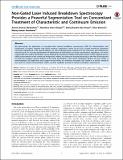Non-Gated Laser Induced Breakdown Spectroscopy Provides a Powerful Segmentation Tool on Concomitant Treatment of Characteristic and Continuum Emission
Author(s)
Myakalwar, Ashwin Kumar; Dingari, Narahara Chari; Dasari, Ramachandra Rao; Barman, Ishan; Gundawar, Manoj Kumar
DownloadMyakalwar-2014-Non-gated laser indu.pdf (494.1Kb)
PUBLISHER_CC
Publisher with Creative Commons License
Creative Commons Attribution
Terms of use
Metadata
Show full item recordAbstract
We demonstrate the application of non-gated laser induced breakdown spectroscopy (LIBS) for characterization and classification of organic materials with similar chemical composition. While use of such a system introduces substantive continuum background in the spectral dataset, we show that appropriate treatment of the continuum and characteristic emission results in accurate discrimination of pharmaceutical formulations of similar stoichiometry. Specifically, our results suggest that near-perfect classification can be obtained by employing suitable multivariate analysis on the acquired spectra, without prior removal of the continuum background. Indeed, we conjecture that pre-processing in the form of background removal may introduce spurious features in the signal. Our findings in this report significantly advance the prior results in time-integrated LIBS application and suggest the possibility of a portable, non-gated LIBS system as a process analytical tool, given its simple instrumentation needs, real-time capability and lack of sample preparation requirements.
Date issued
2014-08Department
Massachusetts Institute of Technology. Department of Chemistry; Massachusetts Institute of Technology. Laser Biomedical Research Center; Massachusetts Institute of Technology. Spectroscopy LaboratoryJournal
PLoS ONE
Publisher
Public Library of Science
Citation
Myakalwar, Ashwin Kumar, Narahara Chari Dingari, Ramachandra Rao Dasari, Ishan Barman, and Manoj Kumar Gundawar. “Non-Gated Laser Induced Breakdown Spectroscopy Provides a Powerful Segmentation Tool on Concomitant Treatment of Characteristic and Continuum Emission.” Edited by Mark G. Kuzyk. PLoS ONE 9, no. 8 (August 1, 2014): e103546.
Version: Final published version
ISSN
1932-6203